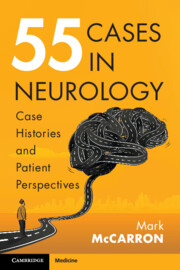Book contents
- 55 Cases in Neurology
- 55 Cases in Neurology
- Copyright page
- Contents
- Preface
- Acknowledgements
- Section 1 Visual Disturbance
- Section 2 Headache and Pain
- Section 3 Weakness
- Section 4 Behavioural and Language Changes
- Case 29 Emotional Consequences
- Case 30 Covalent Cascade
- Case 31 Progressive Silence
- Case 32 Personality Change
- Case 33 Evolving and Changing Neurology
- Section 5 Confusion
- Section 6 Movement Disturbances
- Section 7 Acute Onset of Neurological Symptoms
- Index
- Plate Section (PDF Only)
- References
Case 33 - Evolving and Changing Neurology
from Section 4 - Behavioural and Language Changes
Published online by Cambridge University Press: 27 July 2023
- 55 Cases in Neurology
- 55 Cases in Neurology
- Copyright page
- Contents
- Preface
- Acknowledgements
- Section 1 Visual Disturbance
- Section 2 Headache and Pain
- Section 3 Weakness
- Section 4 Behavioural and Language Changes
- Case 29 Emotional Consequences
- Case 30 Covalent Cascade
- Case 31 Progressive Silence
- Case 32 Personality Change
- Case 33 Evolving and Changing Neurology
- Section 5 Confusion
- Section 6 Movement Disturbances
- Section 7 Acute Onset of Neurological Symptoms
- Index
- Plate Section (PDF Only)
- References
Summary
A 29-year-old woman had a two-year history of intermittent burning in her feet, restless legs, back spasms and tremulousness on wakening. On occasions, her legs ‘left’ her, resulting in falls. She had pins and needles in her face, hands and legs. She had episodes of blurred vision. Her health deteriorated in the year before her first neurology inpatient assessment. Her symptoms continued with tremor, weakness in her legs, cold and burning feelings in her feet, pain in her eyes, blurred vision, pins and needles in her hands and feet, jerks and seizures. Sometimes she was conscious but unresponsive during 30-second seizure-like episodes.
- Type
- Chapter
- Information
- 55 Cases in NeurologyCase Histories and Patient Perspectives, pp. 229 - 236Publisher: Cambridge University PressPrint publication year: 2023



